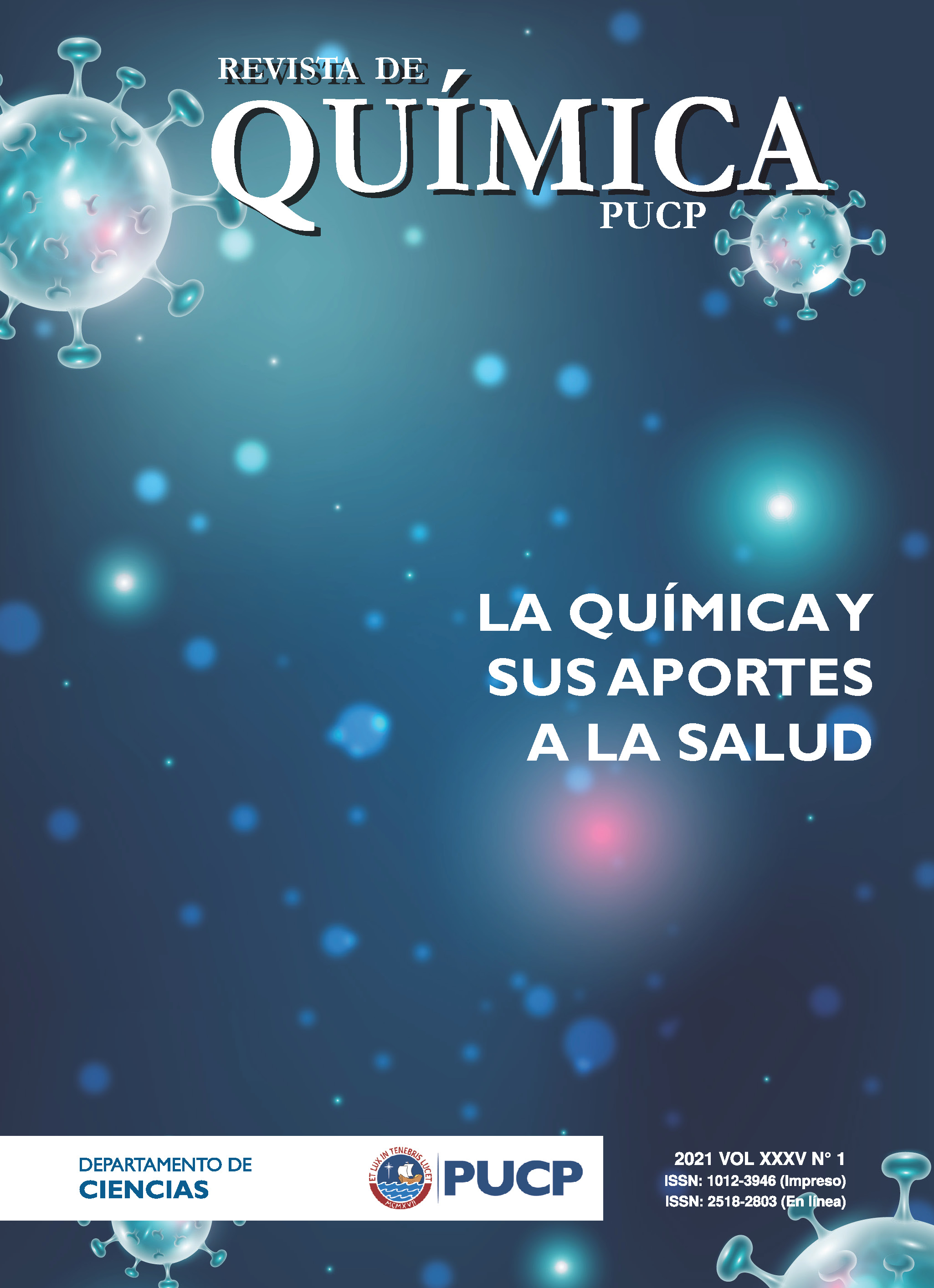El potencial de la nanotecnología para evitar que el SARS-Cov-2 ingrese a nuestro organismo.
Palabras clave:
coronavirus, COVID-19, nanopartículas, nanotecnología, SARS-CoV-2, coronavirus, COVID-19, nanoparticles, nanotechnology, SARS-CoV-2.Resumen
Nos encontramos en una carrera mundial contra la pandemia de COVID-19, una enfermedad infecciosa ocasionada por el virus respiratorio SARS-Cov-2. En este contexto, representan una atractiva alternativa para combatir el virus las propiedades fisicoquímicas de la nanotecnología. En este artículo, se presenta una breve revisión de las distintas herramientas nanotecnológicas desarrolladas para la desactivación del SARS-CoV-2 y evitar que ingrese a
nuestro organismo, mediante su aplicación en equipos de protección personal, superficies inanimadas y sistemas de filtros. Una mejor comprensión de su funcionamiento y de las ventajas que ofrecen son claves para su posible implementación en el Perú.
Descargas
Citas
(1) JOHN HOPKINS UNIVERSITY & MEDICINE, 2021. Mortality Analyses. (accedido 2 de junio de 2021). https://coronavirus.jhu.edu/data/mortality
(2) Ruiz-Hitzky, E.; Darder, M.; Wicklein, B.; Ruiz-Garcia, C.; Martín-Sampedro, R.; del Real, G.; Aranda, P. Nanotechnology Responses to COVID-19. Adv. Healthc. Mater. 2020, 9 (19), 2000979. https://doi.org/10.1002/adhm.202000979
(3) Pemmada, R.; Zhu, X.; Dash, M.; Zhou, Y.; Ramakrishna, S.; Peng, X.; Thomas, V.; Jain, S.; Nanda, H. S. Science-Based Strategies of Antiviral Coatings with Viricidal Properties for the COVID-19 Like Pandemics. Mater. (Basel, Switzerland) 2020, 13 (18). http://dx.doi.org/10.3390/ma13184041
(4) Vazquez-Munoz, R.; Lopez-Ribot, J. L. Nanotechnology as an Alternative to Reduce the Spread of COVID-19. Challenges 2020, 11 (2), 15. http://dx.doi.org/10.3390/challe11020015
(5) Benítez, M. A.; Velasco, C.; Sequeira, A. R.; Henríquez, J.; Menezes, F. M.; Paolucci, F. Responses to COVID-19 in Five Latin American Countries. Heal. policy Technol. 2020, 9 (4), 525–559. https://doi.org/10.1016/j.hlpt.2020.08.014
(6) Valdiglesias, V.; Laffon, B. The Impact of Nanotechnology in the Current Universal COVID-19 Crisis. Let’s Not Forget Nanosafety! Nanotoxicology 2020, 14 (8), 1013–1016. https://doi.org/10.1080/17435390.2020.1780332
(7) Campos, E. V. R.; Pereira, A. E. S.; de Oliveira, J. L.; Carvalho, L. B.; Guilger-Casagrande, M.; de Lima, R.; Fraceto, L. F. How Can Nanotechnology Help to Combat COVID-19? Opportunities and Urgent Need. J. Nanobiotechnology 2020, 18, 1–23. http://dx.doi.org/10.1186/s12951-020-00685-4
(8) Weiss, C.; Carriere, M.; Fusco, L.; Capua, I.; Regla-Nava, J. A.; Pasquali, M.; Scott, J. A.; Vitale, F.; Unal, M. A.; Mattevi, C.; et al. Toward Nanotechnology-Enabled Approaches against the COVID-19 Pandemic. ACS Nano 2020, 14 (6), 6383–6406. https://doi.org/10.1021/acsnano.0c03697
(9) Brydson, R.M.; Hammond, C. Generic Methodologies for Nanotechnology: Classification and Fabrication. En “Nanoscale Science and Technology”; John Wiley & Sons, Ltd.: New Jersey, 2005; pp. 1–55.
(10) Reina, G.; Peng, S.; Jacquemin, L.; Andrade, A. F.; Bianco, A. Hard Nanomaterials in Time of Viral Pandemics. ACS Nano 2020, 14 (8), 9364–9388. https://doi.org/10.1021/acsnano.0c04117
(11) Imani, S. M.; Ladouceur, L.; Marshall, T.; Maclachlan, R.; Soleymani, L.; Didar, T. F. Antimicrobial Nanomaterials and Coatings: Current Mechanisms and Future Perspectives to Control the Spread of Viruses Including SARS-CoV-2. ACS Nano 2020, 14 (10), 1234. https://doi.org/10.1021/acsnano.0c05937
(12) Chung, Y. H.; Beiss, V.; Fiering, S. N.; Steinmetz, N. F. COVID-19 Vaccine Frontrunners and Their Nanotechnology Design. ACS Nano 2020, 14 (10), 12522–12537. https://doi.org/10.1021/acsnano.0c07197
(13) Huang, H.; Fan, C.; Li, M.; Nie, H.-L.; Wang, F.-B.; Wang, H.; Wang, R.; Xia, J.; Zheng, X.; Zuo, X.; et al. COVID-19: A Call for Physical Scientists and Engineers. ACS Nano 2020, 14 (4), 3747–3754. https://doi.org/10.1021/acsnano.0c02618
(14) Prather, K. A.; Wang, C. C.; Schooley, R. T. Reducing Transmission of SARS-CoV-2. Science 2020, 368 (6498), 1422–1424. https://doi.org/10.1126/science.abc6197
(15) Chin, A. W. H.; Chu, J. T. S.; Perera, M. R. A.; Hui, K. P. Y.; Yen, H.-L.; Chan, M. C. W.; Peiris, M.; Poon, L. L. M. Stability of SARS-CoV-2 in Different Environmental Conditions. The Lancet Microbe 2020, 1 (1), e10. https://doi.org/10.1016/S2666-5247(20)30003-3
(16) Zhong, H.; Zhu, Z.; Lin, J.; Cheung, C. F.; Lu, V. L.; Yan, F.; Chan, C.-Y.; Li, G. Reusable and Recyclable Graphene Masks with Outstanding Superhydrophobic and Photothermal Performances. ACS Nano 2020, 14 (5), 6213–6221. https://doi.org/10.1021/acsnano.0c02250
(17) STATNANO. Technology Against Covid-19: Nano Insights into Prevention, Diagnosis, and Treatment. (consulta 2 de junio de 2021). https://statnano.com/technology-against-covid-19-nano-insights
(18) Mazari, S. A.; Ali, E.: Abro, R.: Khan, F. S. A.; Ahmed, I.; Ahmed, M.; Nizamuddin, S.; Siddiqui, T.H.; Hossain, N.; Mubarak, N.M.; Shah, A. Nanomaterials: applications, waste-handling, environmental toxicities, and future challenges-A review. J. Environ. Chem. Eng. 2021, 9(2), 105028. https://doi.org/10.1016/j.jece.2021.105028
(19) RESEARCHANDMARKETS.COM, 2020. Issues Report on Nanotechnology Clothing Global Market Report 2020-30: COVID-19 Growth and Change. Health & Beauty Close - Up (consulta 11 de enero de 2021). https://www.researchandmarkets.com/reports/5321446/nanotechnology-clothing-global-market-report
(20) Hernández, Y.; Lagos, L. K.; Galarreta, B. C. Development of a Label-Free-SERS Gold Nanoaptasensor for the Accessible Determination of Ochratoxin A. Sens. Bio-Sensing Res. 2020, 28, 100331. https://doi.org/10.1016/j.sbsr.2020.100331
(21) RPP, 2020. Proyecto para elaborar mascarillas N95 con nanotecnología obtuvo premio de Concytec contra la COVID-19. https://rpp.pe/tecnologia/mas-tecnologia/coronavirus-en-peru-proyecto-para-elaborar-mascarillas-n96-con-nanotecnologia-obtuvo-el-premio-de-la-campana-contra-la-covid-19-noticia-1261173 (2 de junio de 2021).
(22) ANDINA, 2020. Científicos de la UNI validarán producción de telas que eviten contagio de covid-19. (consulta 2 de junio de 2021). https://andina.pe/agencia/noticia-cientificos-de-uni-validaran-produccion-telas-eviten-contagio-covid19-821784.aspx
(23) UTEC, 2020. COVID-19: “Es motivador ver cómo nuestros alumnos se involucran y buscan espacios para aportar soluciones para el país”. (consulta 2 de junio de 2021). https://www.utec.edu.pe/noticias/covid-19-es-motivador-ver-como-nuestros-alumnos-se-involucran-y-buscan-espacios-para-aportar-soluciones-para-el-pais
(24) DEPARTAMENTO DE INGENIERÍA, 2020. Equipo de la PUCP trabaja para desarrollar una pintura anti COVID-19 para el transporte público. (2 de junio de 2021). https://departamento.pucp.edu.pe/ingenieria/2020/07/30/pucp-desarrollara-una-pintura-anti-covid-19-para-el-transporte-publico/
(25) Sing, K. S. W.; Williams, R. T. The Use of Molecular Probes for the Characterization of Nanoporous Adsorbents. Part. & Part. Syst. Charact. 2004, 21 (2), 71–79. https://doi.org/10.1002/ppsc.200400923
(26) Zangmeister, C. D.; Radney, J. G.; Vicenzi, E. P.; Weaver, J. L. Filtration Efficiencies of Nanoscale Aerosol by Cloth Mask Materials Used to Slow the Spread of SARS-CoV-2. ACS Nano 2020, 14 (7), 9188–9200. https://doi.org/10.1021/acsnano.0c05025
Descargas
Publicado
Cómo citar
Número
Sección
Licencia
Derechos de autor 2021 Betty C. Galarreta, Sylvia Aphang Ly

Esta obra está bajo una licencia internacional Creative Commons Atribución 4.0.













